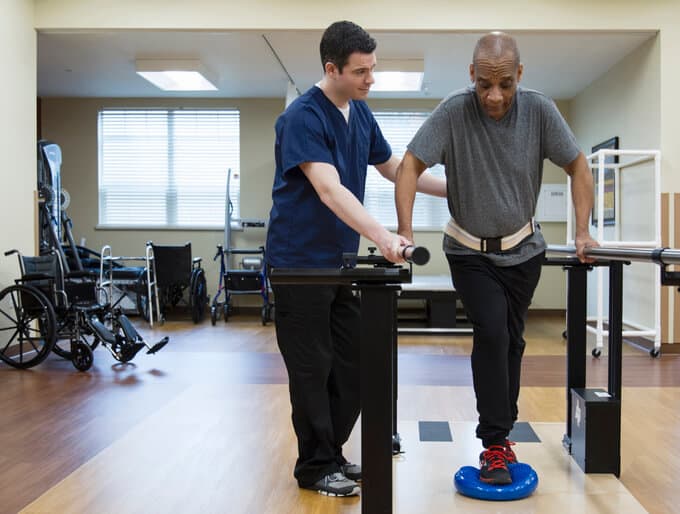Rehabilitation Nurse Career Overview

What Does a Rehabilitation Nurse Do?
Rehabilitation nurses help patients with chronic illness and disabling injuries regain their independence. They collaborate with other healthcare professionals, including physical therapists, occupational therapists, psychiatrists, and speech therapists, regarding patient care.
Primary responsibilities include the following:
Primary Responsibilities
- Direct patient care
- Develop and implement learning resources and discharge plans
- Coordinate nursing care in collaboration with team members
- Serve as a resource and leader for nursing and healthcare staff
- Facilitate community education about people with disabilities
- Advocate at the legislative level
Key Skills
- Client advocacy
- Collaboration
- Leadership
- Research
- Teaching skills

Andersen Ross Photography Inc / DigitalVision / Getty Images
Where Do Rehabilitation Nurses Work?
Rehabilitation nurses work in a variety of settings, including hospitals, inpatient and outpatient rehabilitation centers, community and home healthcare, and long-term care facilities. Listed below are the typical duties rehab nurses perform in some of these workplaces.
Hospitals
Nurses provide rehabilitation care and services, manage personnel and resources, and support research activity.
Rehabilitation Centers
Nurses educate patients and family, direct patient care, collaborate with clients, families, and the rehab team, and advocate for clients.
Community and Home Health Facilities
Nurses assess patients, create and implement goals and care plans, and work with the healthcare team.
Why Become a Rehab Nurse?
Like all nursing careers, rehabilitation nursing offers rewards and challenges. The chart below outlines some of the pros and cons within the profession.
Advantages to Becoming a Rehab Nurse
Opportunities to collaborate and work on teams of healthcare specialists, including occupational and physical therapists, social workers, primary physicians, mental health professionals, and nurse practitioners
Variety of workplace settings, including home healthcare, hospitals, long-term care facilities, rehabilitation centers, and community clinics
Helping patients to adapt to their illnesses and disabilities and regain their strength and independence
Potential career growth into advanced rehab nurse roles and specializations, such as gerontology, pediatrics, and pain management
Disadvantages to Becoming a Rehab Nurse
Physically demanding work that can include heavy lifting and helping patients with mobility
Slower pace compared to other types of nursing, assisting patients who recover gradually and may experience smaller gains
Potentially stressful work when caring for newly diagnosed patients who may be upset, angry, or depressed, along with anxious family members
Career opportunities in advanced nursing and in some specializations may require 2-3 years of additional education and training
How to Become a Rehabilitation Nurse
Rehabilitation Nursing: Advanced Practice vs. RN Roles
Advanced practice registered nurses (APRNs) who specialize in rehabilitation and RN rehabilitation nurses share some overlapping duties, but APRN-level practitioners take on more supervisory, management, and research roles and responsibilities.
APRN Rehabilitation Nurse
- Consultant: Finds and coordinates cases, liaises with third-party payers and other healthcare professionals, and advocates for clients
- Direct Care Provider: Manages patients, serves as a clinical expert, acts as a crisis intervention resource, collaborates with interdisciplinary teams, and implements cost-effective technologies
- Manager: Hires, trains, and evaluates staff, formulates policies and procedures, collects and evaluates program data, and monitors and ensures safe and high-quality services
- Researcher: Guides development of research-based nursing, conducts, shares, or contributes to research, and directs data evaluation
RN Rehabilitation Nurse
- Caregiver: Assesses clients, develops and implements adaptable care plans, and evaluates and modifies care plans to achieve goals and objectives
- Client Advocate: Listens to and guides clients and families, advocates at the policy level, helps clients achieve success when they return to work or school
- Collaborator: Develops goals for clients, families, and rehabilitation teams, participates in conferences and meetings, and works with rehab team members
- Teacher: Educates nurses, clients, and families about diseases and disabilities
How Much Do Rehabilitation Nurses Make?
According to Payscale, the average RN-level rehabilitation nurse salary totals $68,620 per year. Certification leads to increases in both salary and job opportunities, with the average CRRN making $85,340 annually — earnings that exceed the average pay for all RNs.
The U.S. Bureau of Labor Statistics projects a 7% increase in RN jobs from 2019-2029. By contrast, the projected change in employment for all occupations totals 4% for the same period. Demand for RNs should increase due to an aging population facing greater incidences of chronic illness and disabilities and who tend to seek care in either long-term residential facilities or their own homes.
Frequently Asked Questions About Rehabilitation Nurses
What does a rehab nurse do?
Rehabilitation nurses care for patients with chronic illnesses and permanent or temporary disabilities and help them transition back into independent living. Rehab nurses work with patients and their family members and collaborate with interdisciplinary teams. Employment settings include hospitals, clinics, rehabilitation centers, residential facilities, and home healthcare.
What is the difference between a rehabilitation nurse and physical therapist?
Rehabilitation nurses work on teams of medical professionals, including doctors, therapists, and mental healthcare providers, to help implement rehabilitation plans for patients with disabilities and long-term illnesses. An RN working in a rehab center, for instance, may be responsible for the patients’ medical needs such as caring for feeding tubes and catheters. Though physical therapists may work in teams with rehab nurses, physical therapists focus more on improving patients’ movement and mobility issues through therapy and prevention.
What is the role of a nurse in rehabilitation?
Rehab nurses take on a number of roles. RN-licensed rehabilitation nurses act as caregivers, collaborators, educators, and patient advocates. APRN-level practitioners also fill these roles but generally have more supervisory or management responsibility. MSN-holders in rehab nursing often serve as clinical experts, consultants, direct care providers, managers, researchers, and supervisors.
Can an RN become a physical therapist?
RNs complete many of the prerequisites needed to become physical therapists in their ADN or BSN programs, but physical therapists must earn a doctorate in physical therapy, which requires 4-6 more years of study. RNs transitioning into a career in physical therapy also need to pass their state physical therapist licensure exam.
Resources for Rehabilitation Nurses
Association of Rehabilitation Nurses
In addition to conferring CRRN certification, ARN supports rehabilitation nursing with networking and educational resources, advocacy, and research. Member benefits include free continuing education, an online community, special interest groups, local chapters, volunteer opportunities, and publications. ARN offers memberships at the RN/CRRN and nonvoting affiliate levels.The National Rehabilitation Association
NRA advocates for individuals with disabilities and promotes ethical and collaborative rehabilitation practice. Its diverse membership includes professionals in rehabilitation healthcare, counseling, education, and research. NRA enrollment includes state chapter membership; students, new professionals, and retirees can join at discounted rates. Benefits include publications and an annual conference.American Nurses Association
ANA offers specialty certifications in pain management, gerontology, ambulatory care, and other areas applicable to rehabilitation nursing through the American Nurses Credentialing Center. Membership benefits include resources in career advancement, professional development, networking, and advocacy for nurses in all specializations. National Student Nurses Association members can join ANA free of charge.
Related Pages
Reviewed by:

Elizabeth Clarke (Poon) is a board-certified family nurse practitioner who provides primary and urgent care to pediatric populations. She earned a BSN and MSN from the University of Miami.
Clarke is a paid member of our Healthcare Review Partner Network. Learn more about our review partners.








